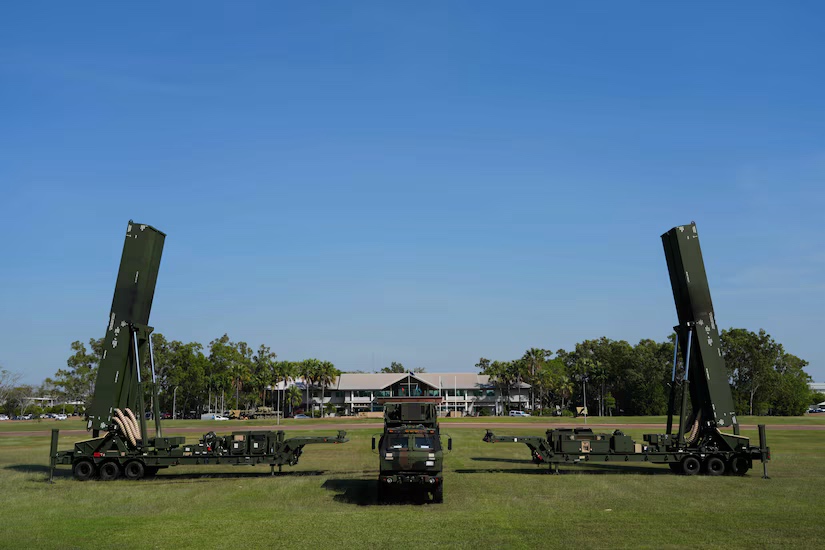Military technology is evolving at a breakneck pace. Weapons systems that defined military superiority for decades and even centuries are becoming obsolete within a matter of years.
Think of tanks, the workhorse of the Second World War. In the ongoing Ukraine War, the most advanced tanks are struggling to hold against cheap, flimsy first-person view (FPV) drones that cost a few thousand dollars.
Or, think of aircraft carriers, the massive floating military bases. For decades, they defined a country’s blue-water capabilities, enabling a military to project power anywhere on Earth. Now, even the most lethal carriers, costing upwards of tens of billions of dollars, are vulnerable to a single anti-ship ballistic missile (ASBM).
In this fast-changing military technology landscape, the U.S. Department of War (DoW) has decided to focus and prioritize on six key technology domains to maintain the U.S. Army’s conventional military superiority.
Curiously enough, none of the six key technology areas includes either a fighter aircraft (no F-47 or B-21 Raider) or an aircraft carrier.
U.S. Military’s Six Key Focus Areas
The Under Secretary of War for Research and Engineering Emil Michael said the plan will deliver faster, more focused results to the warfighter by merging overlapping programs and steering funding toward technologies that will shape future conflicts.
“As the Department of War’s Chief Technology Officer, I am statutorily charged with the mission of advancing technology and innovation for the armed forces,” Michael wrote in a November 13 memorandum to senior Pentagon leadership.
“The previous list of fourteen CTAs (Critical Technology Areas) did not provide the focus that the threat environment of today requires.”
Among those six critical technology areas (CTAs) are Applied Artificial Intelligence (AAI), Biomanufacturing (BIO), Contested Logistics Technologies (LOG), Quantum and Battlefield Information Dominance (Q-BID), Scaled Directed Energy (SCADE), and Scaled Hypersonics (SHY).
The six CTAs are designed to address the most pressing challenges facing the modern battlefield.
“These CTAs represent the cutting edge of research and engineering, designed to deliver immediate, tangible results to the warfighter and ensure the United States remains the most lethal fighting force in the world,” the U.S. Department of War said in a statement.
Underlining the criticality of moving quickly in these areas, Michael said, “Our adversaries are moving fast, but we will move faster. The warfighter is not asking for results tomorrow; they need them today.”
“These six Critical Technology Areas are not just priorities; they are imperatives. The American warfighter will wield the most advanced technology to maximize lethality. This is how the War Department wins wars.”

Secretary of War Pete Hegseth emphasized, “Our nation’s military has always been the tip of the spear. Under Secretary Emil Michael’s six Critical Technology Areas will ensure that our warriors never enter a fair fight and have the best systems in their hands for maximum lethality. The War Department is committed to remaining the most deadly fighting force on planet Earth.”
Applied Artificial Intelligence (AAI)
Among the six, perhaps the most critical area is Applied Artificial Intelligence (AAI).
Notably, the War Department’s focus on AAI also aligns with President Donald Trump’s Artificial Intelligence Action Plan, which directs the War Department to become an “AI-First” organization.
Trump’s Winning the Race: America’s AI Action Plan, released July 23, directed the War Department to aggressively adopt AI to maintain global military preeminence and ensure it is both secure and reliable.
“When adopted rapidly, AI will fundamentally transform the department from the enterprise level to intelligence synthesis and to warfighting,” Michael said.
AAI is the cornerstone of the DoW’s strategy to achieve decision superiority. By embedding AI into command-and-control systems, the Department will enable intelligent workflows.
Biomanufacturing (BIO)
Biomanufacturing uses specially designed genetically modified living organisms, such as bacteria, to manufacture needed materials.
“(Biomanufacturing) harnesses living systems to produce capabilities (critical materials) at scale,” Michael said. “(This effort) will accelerate the development and deployment of biomanufacturing solutions to support critical missions of the department.”
With biomanufacturing, he said, the department can expect development of bio-based alternatives for critical chemicals, minerals, and energetics for use in warfighting systems.
BIO enhances operational resilience and reduces logistical vulnerabilities in unfavorable environments.
Scaled Directed Energy (SCADE)
In the era of drone warfare, directed energy weapons (DEWs) have become critical.
Using high-cost interceptor missile systems, such as the Patriot air defense system, against cheap drones is not economical.
However, the cost per shot for directed energy weapons (DEWs) is significantly lower than traditional munitions, potentially costing as little as US$1 per shot, depending on the technology.
This is in stark contrast to traditional missile interceptors, which can cost millions per shot, making DEWs a more cost-effective option for countering threats like drones.
Another benefit of DEWs is that they offer unlimited magazine depth and could also tackle the threat of drone swarms.
For instance, on October 7, 2023 attack on Israel, Hamas adopted the strategy of overwhelming Israel’s multi-layered air defense system by launching thousands of drones and rockets within 30 minutes.
DEWs could have mitigated such an attack much more effectively.
Many countries, including the UK, India, China, Russia, Israel, and the US, are working on DEWs.
In September, Israel operationalised the ‘Iron Beam’ laser interceptor into its military.
IRON BEAM is a High Energy Laser Weapon System (HELWS) that is expected to become the first operational system in its class.
The Iron Beam uses a high-power laser to intercept and destroy short-range aerial threats, such as rockets, mortars, drones, and cruise missiles, at a fraction of the cost of traditional interceptors.
The cost per shot of Israel’s Iron Beam high-energy laser defense system is approximately US$2 to US$5, whereas the cost of a single Iron Dome interceptor missile, specifically the Tamir missile, is approximately US$50,000 to US$80,000 per shot.
Similarly, the UK’s Laser-based DEW DragonFire puts the cost per shot at less than £10 (about US$13).
In 2024, the US Navy successfully tested its High-Energy Laser with Integrated Optical Dazzler and Surveillance (HELIOS) system on the USS Preble, using it to shoot down an unmanned aerial target.
A focus on directed energy, Michael said, will enable the department to rapidly scale high-energy lasers and high-power microwave systems with widely accessible, low-cost-per-shot response options.
DEWs could also form an essential part of the US’s ambitious Golden Dome project.
Contested Logistics Technologies (LOG)
Contested Logistics Technologies reimagines military sustainment in disrupted or denied environments, ensuring warfighters have access to critical resources.
Robots and AAI could also form an essential part of LOG operations.

The goal, Michael said, is to ensure troops can fight and resupply even when traditional lines are cut.
Quantum and Battlefield Information Dominance (Q-BID)
Q-BID ensures operational effectiveness in contested electromagnetic environments by modernizing communication and sensing technologies.
Scaled Hypersonics (SHY)
SHY will deliver Mach 5+ hypersonic weapons at scale, providing unmatched speed, precision, and survivability.
Conventional ballistic missiles, and even Intercontinental Ballistic Missiles (ICBMs), are no longer very effective against advanced air defense systems, as they move along predictable trajectories.
In comparison, hypersonic weapons can reach Mach 5+ and are highly maneuverable, making interception very difficult.
An ICBM follows a parabolic trajectory, which means it ascends and then descends in a high arc. In contrast, a hypersonic one orbits the Earth at a lower height and is maneuverable. The ability to change track, target, and speed mid-trajectory makes them tougher to track and defend against.
Notably, notwithstanding the US’s traditional military superiority, there is one critical area – hypersonic weapons – where the US is trailing not only its traditional adversaries like Russia and China, but it is also behind novice upstarters like Iran and North Korea, if their claims are to be believed.
In hypersonic missile technology, the US, despite its two-and-a-half decades of efforts and billions of dollars, is still trailing not one, but multiple countries.
It is common knowledge that the United States has actively pursued the development of hypersonic weapons as a part of its conventional prompt global strike program since the early 2000s.
The Pentagon’s FY2025 budget request for hypersonic research was US$6.9 billion, up from US$4.7 billion in FY2023. It was US$3.8 billion in fiscal year 2022.
The US is working on multiple programs simultaneously. Among them are: the Army’s Long-Range Hypersonic Weapon (LRHW), the US Navy’s Conventional Prompt Strike (CPS), and the US Air Force’s Hypersonic Attack Cruise Missile (HACM) program.
Additionally, the Defense Advanced Research Projects Agency (DARPA) supports programs such as the Hypersonic Air-breathing Weapon Concept (HAWC).
However, among these systems, only the U.S. Army’s Long-Range Hypersonic Weapon (LRHW), also known as Dark Eagle, is close to operational status.

The US deployed its ‘Dark Eagle’ LRHW during the Talisman Sabre military drills in Australia in August this year. This marked the first-ever overseas deployment of this sophisticated system.
On the other hand, Russia has three operational hypersonic missiles: the Kinzhal, the Tsirkon, and the Avangard. In June, Russia also gave the order to start mass production of its fourth hypersonic missile, the Oreshnik.
Additionally, China is leading in the global race for hypersonic weapons. China possesses the world’s leading hypersonic arsenal, with systems like the DF-17 capable of targeting U.S. bases in the Pacific.
The US DoW’s sharper focus on hypersonic weapons can help bridge this technological gap with Russia and China.
“Executing these sprints will require unprecedented coordination between the Office of the Under Secretary of War for Research and Engineering, military departments, combatant commands, and other Office of the Secretary of War components,” Michael said.
The US DoW’s focus on these six CTAs highlights where modern warfare is headed. In coming wars, AI, hypersonic weapons, DEWs, secure communication and logistics lines, and bio-manufacturing will be as critical as modern fighter jets and aircraft carriers.
- Sumit Ahlawat has over a decade of experience in news media. He has worked with Press Trust of India, Times Now, Zee News, Economic Times, and Microsoft News. He holds a Master’s Degree in International Media and Modern History from the University of Sheffield, UK.
- VIEWS PERSONAL OF THE AUTHOR
- He can be reached at ahlawat.sumit85 (at) gmail.com




